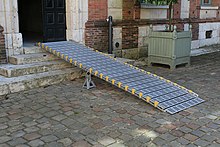
Back Pandus Azerbaijani Пандус Byelorussian Пандус BE-X-OLD Рампа за инвалиди Bulgarian Rollstuhlrampe German Ράμπα πρόσβασης Greek Rampa para silla de ruedas Spanish Luiska Finnish כבש (מישור משופע) HE Пандус Kazakh
The examples and perspective in this article may not represent a worldwide view of the subject. (October 2012) |


A wheelchair ramp is an inclined plane installed in addition to or instead of stairs. Ramps permit wheelchair users, as well as people pushing strollers, carts, or other wheeled objects, to more easily access a building, or navigate between areas of different height. Ramps for accessibility may predate the wheelchair and are found in ancient Greece.[1]
A wheelchair ramp can be permanent, semi-permanent or portable. Permanent ramps are designed to be bolted or otherwise attached in place. Semi-permanent ramps rest on top of the ground or concrete pad and are commonly used for the short term. Permanent and semi-permanent ramps are usually of aluminum, concrete or wood. Portable ramps are usually aluminum and typically fold for ease of transport. Portable ramps are primarily intended for home and building use but can also be used with vans to load an unoccupied mobility device or to load an occupied mobility device when both the device and the passenger are easy to handle.
Ramps must be carefully designed in order to be useful. In many places, laws dictate a ramp's minimum width and maximum slope.[2][3]
In general, reduced incline rises are easier for wheelchair users to traverse and are safer in icy climates. However, they consume more space and require traveling a greater distance to go up. Hence, in some cases it is preferable to include an elevator or other type of wheelchair lift.[4]
In many countries, wheelchair ramps and other features to facilitate universal access are required by building code when constructing new facilities which are open to the public. Internationally, the United Nations Convention on the Rights of Persons with Disabilities mandates nations take action to "enable persons with disabilities to live independently and participate fully in all aspects of life." Among other requirements, it compels countries to institute "minimum standards and guidelines..." for accessibility. [5]
- ^ Curry, Andrew (20 July 2020). "Ramps for disabled people trace back to ancient Greece". Science. doi:10.1126/science.abd9196. S2CID 225541656. Archived from the original on 30 July 2020. Retrieved 29 July 2020.
- ^ "405 Ramps". 2010 ADA Standards for Accessible Design. US Department of Justice. September 15, 2010. Archived from the original on August 22, 2015. Retrieved August 23, 2015.
- ^ "ADA Wheelchair Ramp Specs". Mobility Advisor. Archived from the original on 2015-08-09. Retrieved 2015-08-23.
- ^ "Ramps vs. Lifts | Handi-Lift". www.handi-lift.com. Archived from the original on 2017-10-10. Retrieved 2017-05-09.
- ^ "Convention on the Rights of Persons with Disabilities (CRPD) | United Nations Enable". www.un.org. Archived from the original on 2017-05-11. Retrieved 2017-05-09.
© MMXXIII Rich X Search. We shall prevail. All rights reserved. Rich X Search